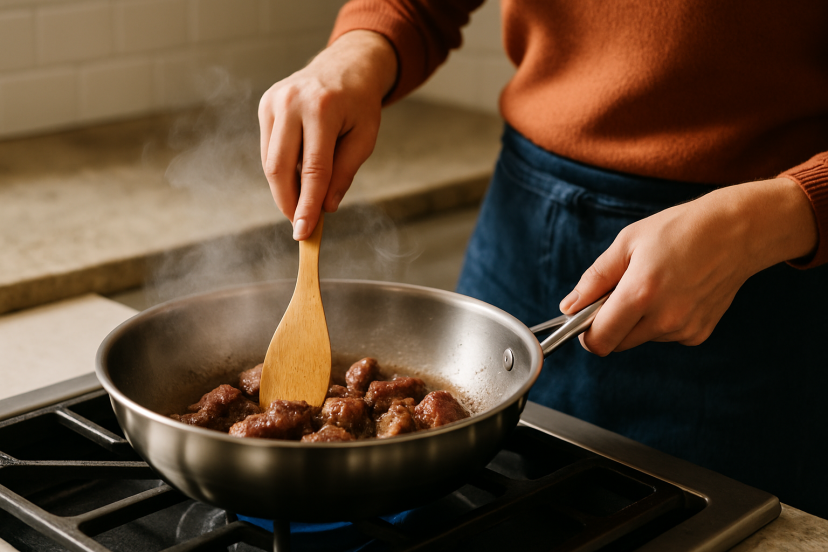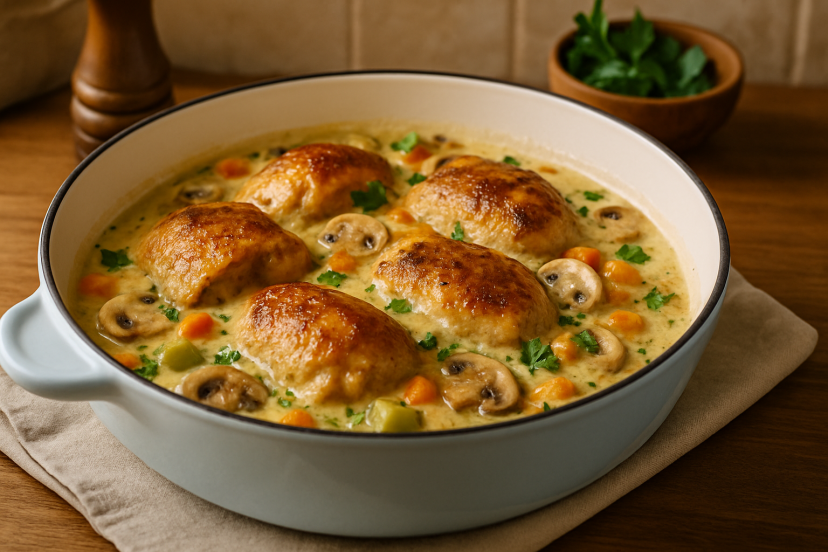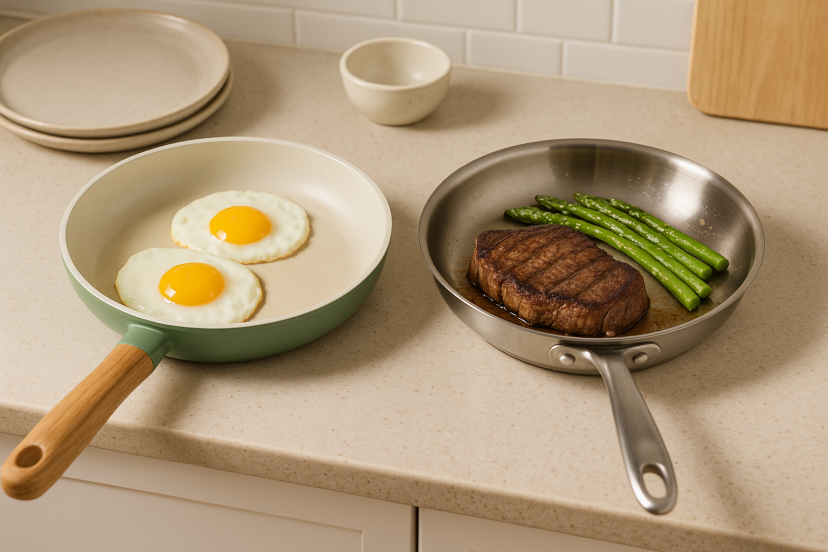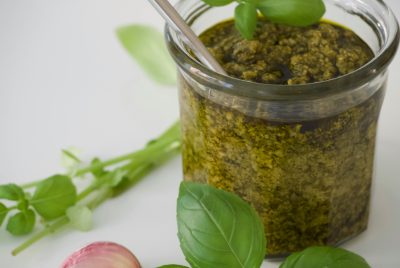Ceramic vs Stainless Steel Cookware: Which Is Better for Home Cooks?
We may earn a commission for purchases made using our links. Please see our disclosure to learn more.
Cooking isn’t just about following recipes—it’s about having the right tools that turn ordinary meals into something extraordinary. When it comes to cookware, the ceramic vs stainless steel debate sparks endless conversations among home cooks and professionals alike. Both promise quality and performance, yet they cater to different cooking needs. Ceramic cookware stands out for its smooth, non-toxic non-stick surface, while stainless steel is celebrated for its unmatched durability and heat control. If you’ve ever dealt with food sticking to the pan or worried about harmful coatings, this guide will walk you through the pros, cons, and science behind both materials—helping you choose the cookware that truly fits your kitchen style.
What Makes Ceramic Cookware Special?
Ceramic cookware has gained massive popularity in recent years thanks to its sleek look and eco-friendly appeal. It’s made with a silica-based coating, usually derived from sand, that creates a naturally non-stick surface—no PFAS, PFOA, or other chemicals.
The Advantages of Ceramic Cookware
- Naturally Non-Stick: Ceramic’s slick surface means you can cook eggs, pancakes, or crepes with minimal oil. Perfect for health-conscious cooks.
- Easy to Clean: Food residue rarely sticks. A soft sponge and mild soap are enough for a spotless pan.
- Quick, Even Heating: Ceramic pans heat up fast and distribute heat evenly, preventing burnt spots.
- Aesthetic Appeal: Available in colors like sage green, cream, or matte black—making them a stylish addition to your kitchen.
- Eco-Friendly Choice: Many ceramic brands prioritize sustainable, toxin-free materials.
The Drawbacks of Ceramic Cookware
- Durability Issues: Ceramic coatings eventually wear off—usually within 2–5 years depending on care.
- Heat Limitations: High heat can crack or fade the coating, so it’s better suited for medium temperatures.
- Scratch Sensitivity: Metal utensils can damage the surface; wood or silicone tools are a must.
- Pitting Over Time: Exposure to strong detergents or dishwashers may cause the coating to degrade.
Best For: Beginners, light cooking, and anyone who values ease and convenience over heavy-duty performance.

Stainless Steel Cookware: The Classic Workhorse
There’s a reason professional chefs swear by stainless steel. Built from a mix of iron, carbon, and chromium (sometimes nickel), stainless steel cookware is designed for precision, longevity, and versatility.
The Advantages of Stainless Steel Cookware
- Unmatched Durability: Stainless steel pans can last decades without warping, denting, or chipping.
- Versatile Cooking Range: From searing steaks to simmering sauces, stainless steel can handle almost any dish.
- High-Heat Tolerance: Perfect for browning, caramelizing, and deglazing—essential steps for flavor-rich meals.
- Non-Reactive Surface: Safe for cooking acidic ingredients like tomatoes or wine-based sauces.
- Professional-Grade Control: Conducts heat evenly when layered with aluminum or copper cores, offering precision for chefs and home cooks alike.
The Drawbacks of Stainless Steel Cookware
- Requires Technique: Without proper preheating or oil, food can stick easily.
- More Maintenance: May require soaking and polishing to maintain its shine.
- Heavier Build: Quality stainless steel is weighty, which can be tiring for some users.
Best For: Experienced cooks or anyone who loves to experiment with textures, browning, and flavor depth.
Ceramic vs Stainless Steel: Side-by-Side Comparison
| Feature | Ceramic Cookware | Stainless Steel Cookware |
| Non-Stick Performance | Excellent; ideal for eggs and pancakes | Moderate; requires preheating and oil |
| Durability | 2–5 years | 10+ years (often lifelong) |
| Heat Tolerance | Best at medium heat | Excellent for all heat levels |
| Ease of Cleaning | Effortless | Requires soaking or scrubbing |
| Chemical Safety | PFAS-free and non-toxic | Non-reactive and corrosion-resistant |
| Maintenance | Minimal | Needs polishing and care |
| Visual Appeal | Trendy colors and matte finishes | Timeless metallic shine |
| Weight | Lightweight | Heavier, more solid feel |
| Best Use Case | Quick, light meals | High-heat, flavor-intensive cooking |
Which Cookware Is Healthier?
When comparing ceramic vs stainless steel cookware, the decision depends on your cooking habits—ceramic is great for quick meals, while stainless steel thrives under high heat. Both materials are considered safe, but they differ in how they interact with food and heat.
Ceramic cookware is often praised for being free of toxic coatings and heavy metals. The silica-based layer doesn’t release harmful fumes, even at high temperatures (though you should still avoid overheating).
Stainless steel, on the other hand, doesn’t have a coating that can wear off. It’s naturally stable and non-reactive—meaning no unwanted substances leach into your food. That’s why it’s the go-to material in professional kitchens and hospitals alike.
Verdict: Both are safe, but if chemical-free non-stick is your goal, ceramic wins. For total heat reliability, stainless steel takes the crown.
When to Choose Ceramic Cookware
If your cooking style is casual and you prioritize ease of use, ceramic cookware is an excellent pick. It’s ideal for:
- Quick breakfasts like omelets or pancakes
- Low-oil cooking for a healthier lifestyle
- Busy households that want easy cleanup
- Aesthetic kitchens that love matching cookware sets
You’ll especially appreciate ceramic if you don’t cook at very high temperatures often—it thrives in gentle, consistent heat environments.
When to Choose Stainless Steel Cookware
Go for stainless steel if you love experimenting in the kitchen or enjoy cooking methods that require high precision and heat control. It’s perfect for:
- Searing meats to perfection
- Deglazing pans for rich sauces
- Browning vegetables evenly
- Slow cooking or simmering stews
It’s also ideal for anyone who prefers long-term value. A high-quality stainless steel set can last a lifetime, making it a better investment for serious home cooks.
5 Best Cookware Picks
These options balance safety, performance, and value for every type of cook:
- GreenPan Rio Ceramic Nonstick Frypan Set – Non-toxic, lightweight, and perfect for daily breakfast cooking.
- Caraway Ceramic Cookware Set – Aesthetically beautiful and completely PFAS-free; ideal for modern kitchens.
- All-Clad D3 Stainless Steel Cookware Set – Professional-level build that offers precise temperature control.
- Cuisinart Multiclad Pro Stainless Steel Pan – Affordable and great for everything from frying to simmering.
- T-fal Initiatives Ceramic Nonstick Cookware Set – Budget-friendly, stylish, and easy to clean—great for beginners.
(Tip: Always check compatibility with induction stoves if you plan to use one.)

Backed by Science: What Studies Reveal
Scientific studies support the ongoing ceramic vs stainless steel cookware debate, showing how each material impacts heat distribution, food quality, and overall safety. Modern ceramic coatings are increasingly recognized as safer alternatives to older fluoropolymer non-stick pans. According to a 2021 review on PFAS migration in cookware, substances like PFOA and PFOS can transfer from traditional non-stick coatings into food, posing long-term health risks. This finding reinforces why PFAS-free ceramic coatings are a smarter, safer option for home cooks.
On the stainless steel side, research published in the Journal of Food Engineering on thermal analysis of multilayer cookware demonstrates how combining metals such as aluminum or copper with stainless steel enhances heat distribution and cooking performance. The study highlights that multi-layered cookware achieves more even heating and better Maillard browning—the golden crust that defines restaurant-quality meals.
Together, these studies confirm that both ceramic and stainless steel cookware can promote healthier, more efficient cooking when used correctly and maintained with care.
Expert Insight: Why Many Cooks Use Both
It’s not unusual to see both ceramic and stainless steel in the same kitchen—and for good reason.
- Use ceramic pans for quick breakfasts, reheating leftovers, and cooking delicate dishes.
- Use stainless steel pans for recipes that require searing, high heat, or complex sauces.
This combination covers every cooking scenario—from easy weekday meals to gourmet weekend feasts.
If you’re setting up your cookware collection, think of them as partners rather than competitors. Ceramic brings convenience, stainless steel brings power—and together, they create balance in your cooking.
Care Tips to Make Them Last
No matter which one you choose, proper care extends the life of your cookware:
For Ceramic Cookware:
- Avoid high heat; medium is ideal.
- Use gentle sponges and mild soap for a hand wash.
- Store with a paper towel between pans to prevent scratches.
For Stainless Steel Cookware:
- Preheat before adding oil to prevent sticking.
- For stubborn stains, apply a paste of baking soda and water..
- Dry immediately to prevent water spots.
These small habits make a big difference in performance and appearance over time.
Conclusion
When comparing ceramic vs stainless steel cookware, it’s clear that each offers unique strengths—ceramic shines for its easy cleanup and non-toxic surface, while stainless steel stands out for its durability and high-heat performance. The best choice often depends on your cooking habits, but for most home cooks, a combination of both delivers the perfect balance of convenience and longevity. Use ceramic for gentle, low-oil dishes and stainless steel for searing or complex meals that need precision. And when it’s time to reward yourself after cooking, try this delicious gluten-free ice cream recipe. It’s a refreshing way to end any meal.
FAQs
1. Is it better to use stainless steel or ceramic pans for cooking?
It depends on your needs. Stainless steel is great for high-heat searing and durability, while ceramic is perfect for non-stick, gentle cooking.
2. Is stainless steel or ceramic better for your health?
Both are healthy options. Ceramic is toxin-free and non-stick, while stainless steel doesn’t leach chemicals or react with food.
3. What downsides might ceramic cookware have?
It’s less durable, prone to scratches, and can’t handle very high heat for long periods.
4. Do professional chefs use ceramic cookware?
Chefs typically use stainless steel for its performance, but many use ceramic for eggs or low-fat dishes.
5. What is the healthiest cookware?
The healthiest cookware is one that’s non-reactive, easy to clean, and used properly—both ceramic and stainless steel fit that bill.




